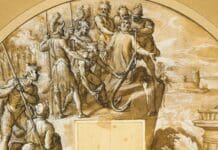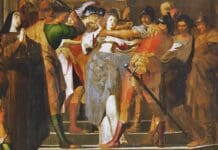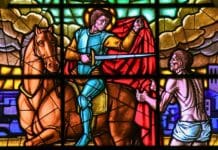 In the 4th and 5th centuries debates about the nature of Christ raged in the Church. The debate was about the relationship of Christ’s divine and human natures. At the center of this debate was a title of Mary. Since at least the 3rd century, Christians had referred to Mary as theotokos, meaning “God-bearer.” The first documented usage of the term is in the writings of Origen of Alexandria in AD 230. Related to theotokos, Mary was called the Mother of God.
In the 4th and 5th centuries debates about the nature of Christ raged in the Church. The debate was about the relationship of Christ’s divine and human natures. At the center of this debate was a title of Mary. Since at least the 3rd century, Christians had referred to Mary as theotokos, meaning “God-bearer.” The first documented usage of the term is in the writings of Origen of Alexandria in AD 230. Related to theotokos, Mary was called the Mother of God.
Referring to Mary this way was popular in Christian piety, but the patriarch of Constantinople from 428-431, Nestorius, objected. He suggested that Mary was only the mother of Jesus’ human nature, but not his divine nature. Nestorius’ ideas (or at least how others perceived his arguments) were condemned at the Council of Ephesus in AD 431, and again at the Council of Chalcedon in AD 451. The Church decided that Christ was fully God and fully human, and these natures were united in one person, Jesus Christ. Thus Mary could be called “mother of God” since she gave birth to Jesus who was fully divine as well as human. Since this time, Mary has been frequently honored as the “mother of God” by Catholics, Orthodox, and many Protestants.
The Solemnity of Mary Mother of God falls exactly one week after Christmas, the end of the octave of Christmas. It is fitting to honor Mary as Mother of Jesus, following the birth of Christ. When Catholics celebrate the Solemnity of Mary Mother of God we are not only honoring Mary, who was chosen among all women throughout history to bear God incarnate, but we are also honoring our Lord, who is fully God and fully human. Calling Mary “mother of God” is the highest honor we can give Mary. Just as Christmas honors Jesus as the “Prince of Peace,” the Solemnity of Mary Mother of God honors Mary as the “Queen of Peace” This solemnity, falling on New Year’s Day, is also designated the World Day of Peace.
The origins of a feast celebrating Mary’s divine maternity are obscure, but there is some evidence of ancient feasts commemorating Mary’s role as theotokos. Around 500 AD the Eastern Church celebrated a “Day of the Theotokos” either before or after Christmas. This celebration eventually evolved into a Marian feast on December 26th in the Byzantine calendar and January 16th in the Coptic calendar. In the West, Christmas has generally been celebrated with an octave, an eight day extension of the feast. The Gregorian and Roman calendars of the 7th century mark the Christmas octave day with a strong Marian emphasis. However, eventually in the West, the eighth day of the octave of Christmas was celebrated as the Feast of the Circumcision of Jesus. The push for an official feast day celebrating Mary’s divine maternity started in Portugal, and in 1751 Pope Benedict XIV allowed Portugal’s churches to celebrate Mary’s divine maternity on the first Sunday in May. The feast was eventually extended to other countries, and by 1914 was being celebrated on October 11. The feast of Mary’s divine maternity became a universal feast in 1931.
However, following Vatican II, Pope Paul VI decided to change the feast of Jesus’ Circumcision to the Solemnity of Mary Mother of God to reclaim the ancient Western Marian emphasis at the end of the Octave of Christmas. Celebrating Mary’s divine maternity during the Christmas octave makes complete sense in that the celebration is connected closely to Christ’s birth. Pope Paul VI gave his reasoning for the change:
In the revised arrangement of the Christmas season, we should all turn with one mind to the restored solemnity of the Mother of God. This feast was entered into the calendar in the liturgy of the city of Rome for the first day of January. The purpose of the celebration is to honor the role of Mary in the mystery of salvation and at the same time to sing the praises of the unique dignity thus coming to “the Holy Mother…through whom we have been given the gift of the Author of life.” This same solemnity also offers an excellent opportunity to renew the adoration rightfully to be shown to the newborn Prince of Peace, as we once again hear the good tidings of great joy and pray to God, through the intercession of the Queen of Peace, for the priceless gift of peace. Because of these considerations and the fact that the octave of Christmas coincides with a day of hope, New Year’s Day, we have assigned to it the observance of the World Day of Peace (Paul VI, Marialis Cultus, Feb. 2, 1974, no.5).
Thus Pope Paul VI highlighted the feast’s celebration of both Mary and Jesus. He also noted the connection to New Year’s Day and Mary’s role as Queen of Peace. January 1st, the Solemnity of Mary Mother of God is also the observed “World Day of Peace.”
















